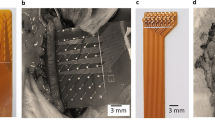Abstract
Objective
To investigate the relationship between tissue-level bioelectrical signals and tension development during oxytocin-stimulated contractions of human myometrium.
Methods
We performed in vitro muscle bath experiments on human myometrial tissue strips while simultaneously monitoring bioelectrical activity with two loose-contact electrodes. Tissue was obtained by myometrial biopsy from term pregnant women at the time of cesarean delivery. Tissue strips (1 × 1 xs 10 mm) were hung vertically and maintained in culture in media while suspending a 400-mg weight. The tissue exhibited strong isometric contractions in response to 5-nM oxytocin even after 10 to 14 days in culture. The electrodes were separated by 4 mm, and allowed us to distinguish between local and tissue-level bioelectrical signals. Electrical activity was monitored using two, independent AC-coupled amplifiers.
Results
Following exposure to oxytocin, the tissue contracted periodically every 3.5 to 6 minutes, with each contraction lasting 50 to 60 seconds. Near the beginning of each contraction, synchronized spike-like bioelectrical signals were observed in both channels. These bioelectrical signals from each electrode lasted approximately 2 seconds and demonstrated unique fingerprints that were repetitive and remarkably similar over 18 contractions. In each of the contractions, the onset of rapid force increases was synchronized with the bioelectrical signals. Cell recruitment continued during the plateau phase of each contraction even though other tissue-level bioelectrical signals were not observed.
Conclusion
These findings suggest that the trigger for the initiation of each contraction is a tissue-level bioelectrical event, and some cells are initially recruited to participate in each contraction by excitation-contraction coupling. After the initial phase of the contraction, cells are recruited by a nonelectrical mechanism.
Similar content being viewed by others
References
Wray S, Jones K, Kupittayanant S, et al. Calcium signaling and uterine contractility. JSoc Gynecol Investig 2003;10:252–64.
Forman A, Andersson KE, Persson CG, Ulmsten U. Relaxant effects of nifedipine on isolated, human myometrium. ActaPharmacol Toxicol (Copenh) 1979;45:81–6.
Parkington HC, Tonta MA, Brennecke SP, Coleman HA. Contractile activity, membrane potential, and cytoplasmic calcium in human uterine smooth muscle in the third trimester of pregnancy and during labor. AmJ Obstet Gynecol 1999;181:1445–51.
Buhimschi C, Boyle MB, Garfield RE. Electrical activity of the human uterus during pregnancy as recorded from the abdominal surface. ObstetGynecol 1997;90:102–11.
Eswaran H, Preissl H, Wilson JD, Murphy P, Robinson SE, Lowery CL. First magnetomyographic recordings of uterine activity with spatial-temporal information with a 151-channel sensor array. AmJ Obstet Gynecol 2002;187:145–51.
Young R. Coordination of myometrial contractility. FrontHorm Res 2001;27:201–15.
Fay FS. Isometric contractile properties of single isolated smooth muscle cells. Nature 1977;265:553–6.
Young RC, Hession RO. Paracrine and intracellular signaling mechanisms of calcium waves in cultured human uterine myocytes. ObstetGynecol 1997;90:928–32.
Young RC, Hession RO. Intra-and intercellular calcium waves in cultured human myometrium. JMuscle Res Cell Motil 1996;17:349–55.
Young RC, Schumann R, Zhang P. The signaling mechanisms of long distance intercellular calcium waves (far waves) in cultured human uterine myocytes. JMuscle Res Cell Motil 2002;23:279–84.
Garfield RE, Sims SM, Kannan MS, Daniel EE. Possible role of gap junctions in activation of myometrium during parturition. AmJ Physiol 1978;235:C168–79.
Balducci J, Risek B, Gilula NB, Hand A, Egan JF, Vintzileos AM. Gap junction formation in human myometrium: A key to preterm labor? AmJ Obstet Gynecol 1993;168:1609–15.
Verheijck EE, Wilders R, Joyner RW, et al. Pacemaker synchronization of electrically coupled rabbit sinoatrial node cells. JGen Physiol 1998;111:95–112.
Boccaletti S, Kurths J, Osipov G, Valladares DL, Zhou CS. The synchronization of chaotic systems. PhysRep 2002;366:1–101.
Kiss IZ, Zhai Y, Hudson JL. Emerging coherence in a population of chemical oscillators. Science 2002;296:1676–8.
Author information
Authors and Affiliations
Corresponding author
Additional information
Financial support provided by National Institutes of Health, Child Health and Human Development grant 1R01HD 36373.
Rights and permissions
About this article
Cite this article
Young, R.C., Zhang, P. Tissue-Level Bioelectrical Signals as the Trigger for Uterine Contractions in Human Pregnancy. Reprod. Sci. 11, 478–482 (2004). https://doi.org/10.1016/j.jsgi.2004.05.005
Published:
Issue Date:
DOI: https://doi.org/10.1016/j.jsgi.2004.05.005




